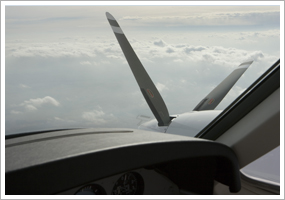| The following stories from the September 25, 2009, edition of AOPA ePilot were provided to AOPA members who expressed an interest in the particular subject areas. Any AOPA member can receive information tailored to their areas of interest by updating their preferences online. TRAINING TIPsEngine-out landings Simulations being what they are, some elements of forced landing procedures don’t always get their due. For example, when an off-airport landing is imminent, what’s to be done about your aircraft’s flaps, fuel, and electrical systems? Should aircraft doors be opened before touchdown, or left alone? Be sure to review these procedural details, even if only by stating to your instructor what steps you would have taken. “One problem with making forced landings is that pilots may be unintentionally biased by their training. For safety reasons, instructors use a good field when practicing emergency landings. In the real world, Murphy's Law almost guarantees that an engine failure will occur at low altitude over inhospitable terrain. If pilots have been conditioned to think that a reasonable landing site is always available, they may not react appropriately in situations that have no reasonable alternatives,” Robert N. Rossier pointed out in “ Learning Experiences: Emergency Landings.” There are many decisions to make. The forced landing without engine power checklist for a 1980 Cessna 152 has nine action items. Among them: placing the mixture in the idle cutoff position, shutting off fuel and ignition (to prevent a fire), and unlatching doors before landing. The electrical system? Don’t shut it down until after final flaps have been set. On the glide, follow recommended airspeeds (65 KIAS flaps up, 60 KIAS flaps down in the Cessna 152). To see how pilots faced with the real thing made good and bad decisions, see “Accident Analysis: Boundary Issues: The long and the short of forced landings” on AOPA Flight Training Online. Then sharpen your thinking by taking the AOPA Air Safety Foundation’s Safety Quiz " Emergency Procedures." Now you’re ready to get the most out of your emergency procedures practice!TRAINING PRODUCTSClub helps pilots master instrument navigationInstrument-rated pilots looking for a way to increase their proficiency and confidence flying in instrument meteorological conditions have a new resource: the IMC Club. The club, based in Norwood, Mass., is opening its free membership nationwide and encouraging pilots to start chapters in their area. The IMC Club offers biweekly meetings to permit instrument students, pilots, and flight instructors to discuss instrument flying, stay engaged in the aviation community, and maintain their instrument-flying skills. For more information or to form a chapter in your area, see the Web site.
Note: Products listed have not been evaluated by ePilot editors unless otherwise noted. AOPA assumes no responsibility for products or services listed or for claims or actions by manufacturers or vendors. FINAL EXAMQuestion: I recently passed my private pilot checkride. Do I still need to carry my logbook with me when I go flying?
Answer: No. Student pilots are required to carry their logbooks with them when flying solo because they contain endorsements that authorize solo flight privileges. FAR 61.3 outlines the required certificates and documents that a pilot must carry when operating as pilot in command. Included in the list are your pilot certificate, medical certificate, and government-issued photo ID—but not your logbook. It may actually be a good idea to leave your logbook at home as it decreases the likelihood of theft, loss, and damage. For additional information on logbooks and logging flight time, take a look at our subject report on the topic.
Got a question for our technical services staff? E-mail to [email protected] or call the Pilot Information Center, 800/872-2672. Don't forget the online archive of "Final Exam" questions and answers, searchable by keyword or topic. |
 Most simulations of engine failure during training conclude after the flight instructor and student glide to a low but safe altitude and then evaluate whether the bid to reach the landing site would have succeeded. (
Most simulations of engine failure during training conclude after the flight instructor and student glide to a low but safe altitude and then evaluate whether the bid to reach the landing site would have succeeded. ( 